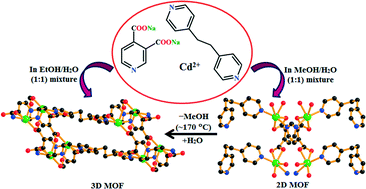Two metal–organic frameworks of Cd(II) from 3,4-pyridinedicarboxylate (3,4-pyrdc) and 1,2-bis(4-pyridyl)ethane (bpe) ligands, {[Cd(3,4-pyrdc)(bpe)(CH3OH)]·(H2O)}n (1) and {[Cd(3,4-pyrdc)(bpe)0.5(H2O)]·(H2O)}n (2) have been synthesized by changing the reaction medium. Compound 1 exhibited a 2D structure while compound 2 showed a 3D structure, which have both been revealed by single crystal X-ray studies. Both of the compounds showed interesting solvent mediated reversible structural transformations which have been established by exhaustive X-ray powder diffraction studies, elemental analysis, IR spectroscopy and thermogravimetric analysis. The desolvated form of the 2D framework (1) undergoes an irreversible structural transformation to form the 3D framework (2) upon soaking with water. The 2D to 3D transformation occurs through precise bond rotation and bond breaking which has been established by a GC–MS study. Sorption experiments with different gases and volatiles were performed for both the metal–organic frameworks and clearly indicated the differences in their inherent flexibility and transformability.
